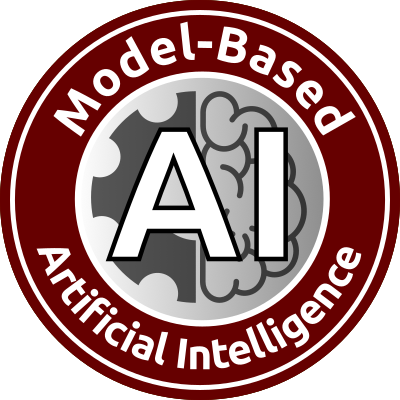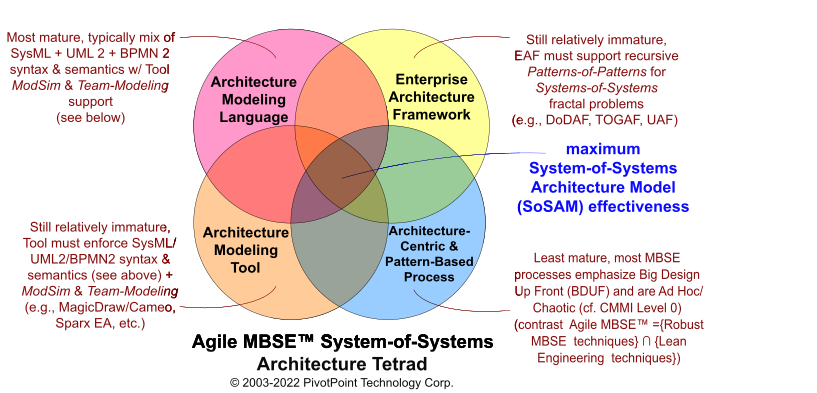SysML FAQ: What is Model-Based Systems Engineering?
Model-Based Systems Engineering (MBSE), a.k.a. Model-Based Systems Development (MBSD), is a Systems Engineering process paradigm that emphasizes the application of rigorous architecture modeling principles and best practices to Systems Engineering activities throughout the System Development Life Cycle (SDLC). These Systems Engineering activities include, but are not limited to, requirements analysis, functional analysis, performance analysis, system design, trade studies, system architecture specification, and system Verification & Validation (V&V).
Model-Based Systems Engineering principles and best practices continue to evolve. The following are some additional desirable characteristics of MBSE approaches:
• emphasize a precise and complete System Architecture Model "blueprint", typically organized using an Architecture Framework with multiple Views/Viewpoints, as the primary work artifact throughout the System Development Life Cycle (SDLC);
• promote the use of open standards for architectural modeling and tool interoperability (e.g., SysML, UML 2, XMI, AP233), where these open standards are used to specify the System Architecture Model and to serve as a lingua franca among Systems Engineers and other stakeholders (Software Engineers, Electrical Engineers, Mechanical Engineers, Customers, etc.);
• ensure that the System Architecture Model is requirements-driven to the extent that all model elements must be fully traceable to system and user requirements;
• ensure that the System Architecture Model is architecture-centric to the extent that all model elements must maintain structural and functional integrity relationships, and support full derivation traceablity across all system stakeholder Views and Viewpoints;
• combine traditional Systems Engineering best practices with architecture modeling best practices.
The term Model-Based Systems Engineering and its acronym MBSE are popular among Systems Engineers who advocate the use of SysML as a standard architecture modeling language for Systems Engineering applications, and who want to distinguish their approach from Model-Driven Development and its variants, which tend to be software-centric.
For more information about Model-Based Systems Engineering, check out the MBSEworks.com web.
• emphasize a precise and complete System Architecture Model "blueprint", typically organized using an Architecture Framework with multiple Views/Viewpoints, as the primary work artifact throughout the System Development Life Cycle (SDLC);
• promote the use of open standards for architectural modeling and tool interoperability (e.g., SysML, UML 2, XMI, AP233), where these open standards are used to specify the System Architecture Model and to serve as a lingua franca among Systems Engineers and other stakeholders (Software Engineers, Electrical Engineers, Mechanical Engineers, Customers, etc.);
• ensure that the System Architecture Model is requirements-driven to the extent that all model elements must be fully traceable to system and user requirements;
• ensure that the System Architecture Model is architecture-centric to the extent that all model elements must maintain structural and functional integrity relationships, and support full derivation traceablity across all system stakeholder Views and Viewpoints;
• combine traditional Systems Engineering best practices with architecture modeling best practices.
The term Model-Based Systems Engineering and its acronym MBSE are popular among Systems Engineers who advocate the use of SysML as a standard architecture modeling language for Systems Engineering applications, and who want to distinguish their approach from Model-Driven Development and its variants, which tend to be software-centric.
For more information about Model-Based Systems Engineering, check out the MBSEworks.com web.
UML, BPMN, OMG SYSML and UPDM are trademarks of the Object Management Group.
TOGAF and ARCHIMATE are trademarks of The Open Group.
ENTERPRISE ARCHITECT is a trademark of Sparx Systems Pty Ltd. MAGICDRAW and CAMEO are trademarks of No Magic, Inc. RATIONAL RHAPSODY is a trademark of IBM.
All other trademarks are the property of their respective owners.
© 2003-2024 PivotPoint Technology Corp. | Terms of Use | Privacy | Contact Us



